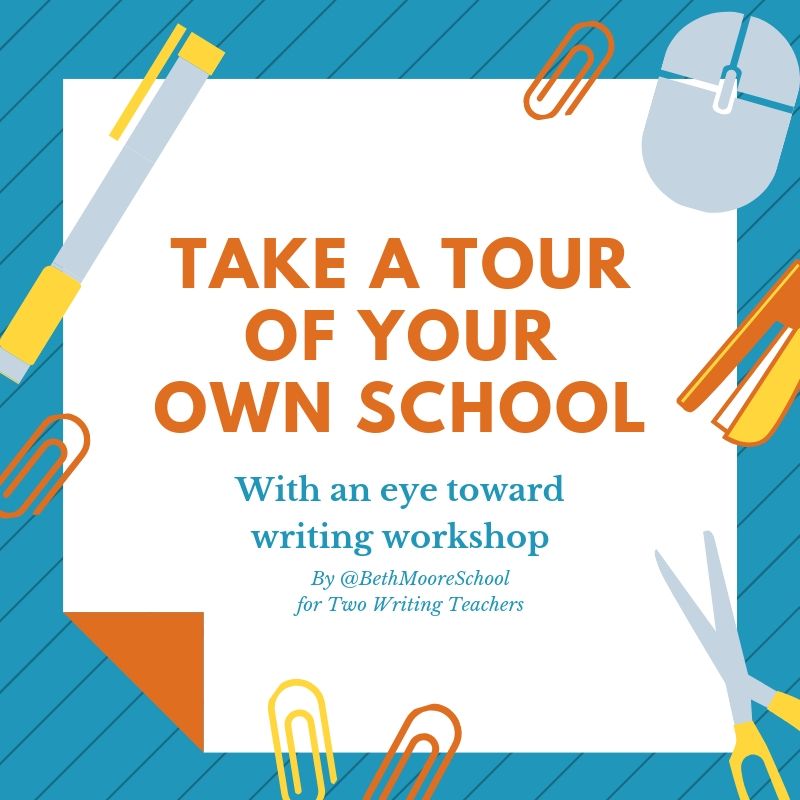
When you have a chance, take a walk through the hallways of your own school. Try to see with fresh eyes. Pretend you are a visitor. Ask yourself:
- What kind of writing is on display? What kind of writing is not on display?
- If what we display in the hallways conveys a message about what we value in our school, what is the message here?
- What else are you noticing?
- What else are you wondering?
If you can, poke your head into a few classrooms that are not your own. If you are lucky, you teach in a school where this is the norm and people visit each other all the time. If you are not so lucky, I have some tips for you later in this post, based on my own not-so-lucky experiences.
When you visit classrooms, ask yourself:
- How is this seating in this room set to support independent writing?
- How is the meeting area set up for the whole class to comfortably come together for whole class minilessons?
- Do you observe kids using anchor charts? Which ones are most popular?
- What systems are set up for kids to access writing supplies on their own?
- What else are you noticing?
- What else are you wondering?
What if you teach in a school where popping into each other’s classroom is not the norm?
It is definitely worth it to work on this change in your school culture. Visiting each other’s classrooms is a key component to collaboration, building community among teachers, learning from each other, transparency, and working together to support all our students. Teaching writing workshop is challenging. Doing it alone is even more challenging. How can truly support each other’s work if it’s kept secret behind closed doors?
As a literacy coach and consultant I have worked in many schools where it has not been the usual practice to visit each other’s classrooms. Sometimes I am the first “outsider” to visit a classroom informally in years. It takes baby steps, and lots of time to change this aspect of school culture. I’ve made a lot of mistakes with this, and through trial and error I have learned a lot over the years.
The good thing is, you don’t need to repeat the same mistakes I’ve made. Here are a few lessons I’ve learned (the hard way):
- Be genuinely curious about something one or more of your colleagues has mentioned in their classroom(s).
- If you aren’t even a little curious about anything any of your colleagues are doing in their classrooms, push yourself to dig a little deeper. There has to be something.
- Ask (nicely) ahead of time if you can stop by the other person’s classroom, and when would be a good time.
- Be super informal about it. Visiting each other’s classrooms should be NO BIG DEAL. Try saying something like, “Hey, would it be cool if I swung by to see your {insert something to do with writing that you are genuinely curious about}?” Don’t say: “Hello. I will be observing your lesson at 10:00am sharp. Be prepared.” (I’m only exaggerating a little here–seriously, don’t be too formal. It only makes people wary.)
- When you enter the classroom, be positive. Smile. Try not to interrupt instruction or be disruptive in any way. Sometimes I say to the kids, “Pretend I’m not even here! I’m just getting some ideas from your awesome teacher!” Take a good look around. Only take photos of things if it’s okay with the teacher. Say thanks–and leave.
- Take most of your notes outside the classroom if you can. Standing there with a clipboard writing extensively doesn’t do a lot for making classroom visits appealing to most people.
- Send a thank you note or email after with a positive note of feedback.
Being the person to break the unspoken closed-door policy in a school is a huge challenge, but it is worth it. I have witnessed schools transform because a few teachers started visiting each other. You just have to trust me on this one.
At the opposite end of the continuum, maybe your school is ready to take it to the next level with a more organized open door policy.
In some schools, visiting each other’s classrooms is an intentional move on teachers’ parts to foster positive school culture and continued professional learning. The #observeme movement on Twitter, and the Pineapple Chart are two examples of teachers seeing the power in learning from each other.


This post is SO, SO helpful!!!
Know that it will help me as I start at a new school next year and want to build a community of learning from others. I did NOT know of the Pineapple Chart and so appreciate you adding the link. Know you are helping better teaching happen in VA, Beth.
LikeLike
All of this is great… especially the nudge to be the person who changes one’s school culture by stepping into colleagues’ classrooms with genuine curiosity.
LikeLike
Great post! And curiosity is truly a great beginning point! Thanks!
LikeLike